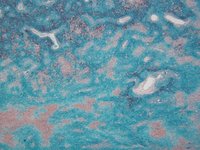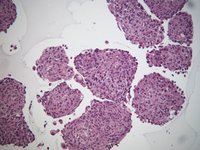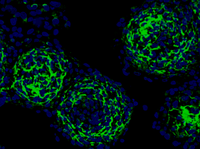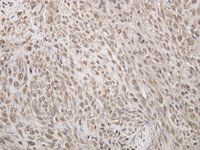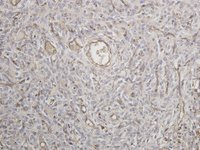- Histology and Embryology /
- Research /
- Research projects /
- Osteosarcoma
c-Kit (CD117) and kit ligand (stem cell factor) expression in canine and feline osteosarcomas
Tyrosine kinase inhibitors are modern pharmaceutical drugs which are able to block important signal transduction cascades essential for cancer cell growth. A potential candidate for a therapeutic application is the tyrosine kinase CD117 (c-kit, stem cell factor receptor), as this receptor is often overexpressed on tumour cells. CD117 positive cells showed high metastatic and drug-resistant properties in human osteosarcoma cells. In our study the presence and distribution of CD117 and its ligand (SCF) is determined on cultured osteosarcoma cellsand clinical tumour samples of dogs and cats by immunohistochemistry and western blot on the protein level and PCR on the mRNA level. Knowing about the presence or the absence of potential targets in osteosarcoma samples of companion animals will help in future to use targeted therapy in a specific individualized therapeutic approach in veterinary medicine as well.
Strategy for reference genes in osteosarcoma research
The analysis of transcript expression by Reverse transcription quantitative PCR (RT-qPCR) requires appropriate data normalization compensating for biological and technical fluctuations. The accuracy of RT-qPCR data was shown to improve from a normalization strategy specifically adjusted to the biological context of the experimental study, for example a specific type of tissue, a physiological or disease state, etc. Here we apply an educated guesswork-free approach selecting reference sequences from high-throughput RNA expression data for the context of canine osteosarcoma. The geometric averaging of multiple internal control sequences specifically selected for the experimental context will allow more accurate normalization of RT-qPCR data.
Osteosarcoma associated macrophages
Tumour associated macrophages are critical factors for tumour progression and metastases by cytokine release. They might have a supporting or inhibiting function on different types of tumour cells depending on their activation status. Data regarding osteoclasts are conflicting as it has been reported that their ablation leads to an increase or reduction of tumour burden. We attempt to analyse the different macrophage populations within canine and feline osteosarcomas (including giant cells and osteoclasts) by means of immunohistochemistry.


